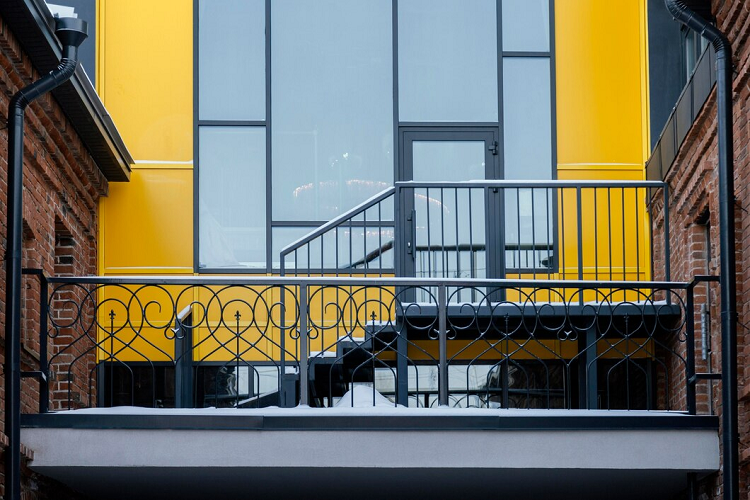Handrail offers assistance and steadiness when navigating a lavatory, going up or down stairs, or strolling along a corridor or walkway. Older populations provide an additional point of contact, and for younger populations, they are a huge asset. Handrails can create safer environments when utilized correctly by reducing the frequency of falls.
Handrails should ideally have a ”power grip,’ which allows the entire hand to grab the rail rather than just the fingers, more severe injuries during a fall.’ In addition to being crucial for safety, outdoor handrails and outdoor stair railing can greatly improve the external appearance of your house.
Walking on a walkway, climbing up or down stairs, moving through a hallway, or using a lavatory all require the support and stability of an extended rail fastened to posts or walls. They offer a feature of universal design that is advantageous to all demographics.

Different Materials for Outdoor Handrail
Selecting the appropriate material for an outdoor handrail is essential for both safety and style. Diverse materials provide differing degrees of toughness, upkeep needs, and aesthetic appeal. We’ll look at the best materials for outdoor handrails in this article, considering things like durability, ease of upkeep, and design flexibility.
Steel Galvanised by Hot Dipping
Outdoor handrails are typically made of hot-dipped galvanized (HDG) steel because of its affordability, low maintenance requirements, and longevity. By applying a layer of zinc to the steel, the galvanizing process fortifies it against the most aggressive weather conditions. The weather, including proximity to corrosive zones or salted roads, can affect how long hot-dip galvanized steel lasts. When choosing the right thickness for a galvanized coating, it is imperative to consider the surrounding conditions.
Stainless Steel
One of the most often used and best materials for outdoor handrails in commercial projects is stainless steel. It is well known for having outstanding corrosion resistance and durability, which makes it perfect for weather resistance. Rain, snow, and extremely high or low temperatures can all be experienced by stainless steel handrails without causing rust or degradation.
Wood
Wood is a popular choice for outdoor handrails, offering a classic and natural aesthetic. Its versatility allows for customization to match your outdoor design. While wood provides a good grip, it requires regular maintenance, such as sealing or painting, to protect against weathering, rot, and insects. Wood handrails produce a cozy, welcoming ambiance while blending in perfectly with the surrounding natural environment. If you don’t maintain them, they may rot, warp, or decay. Despite its susceptibility to wear, many appreciate the warmth and traditional charm that wood brings to outdoor spaces.
Vinyl or PVC
Vinyl or PVC handrails are practical choices for outdoor settings, combining durability with low maintenance. Resistant to weather, insects, and rot, they offer a wide range of styles and colors to suit various designs. While lacking the natural warmth of wood or the sleekness of metal, their longevity and ease of care make them appealing. Over time, vinyl may experience some fading in direct sunlight, but overall, it’s a practical and cost-effective solution for outdoor handrails.
Aluminium
Aluminium is a lightweight, reasonably priced substitute for steel that has exceptional corrosion resistance. This material acts as a barrier against rust and corrosion by naturally forming an oxide layer of protection on its surface. Because they won’t rust, aluminium handrails are especially good for places with high humidity or close to the coast. Furthermore, powder-coating aluminium handrails in a range of hues and finishes add durability and virtually limitless design options.
Concrete
Concrete is a robust choice for outdoor handrails, known for its durability and ability to withstand harsh weather conditions. Its moldable nature allows for diverse design options, though professional installation may be necessary due to its weight. While concrete handrails offer longevity, they can be susceptible to cracking over time, especially in regions with freeze-thaw cycles. Despite potential drawbacks, concrete remains a sturdy and resilient material for outdoor handrail applications.
Glass
Glass handrails provide a modern touch to outdoor spaces, offering an unobtrusive design that allows for clear views. Resistant to weather and easy to clean, they create an open and spacious feel. While glass handrails are visually appealing, they can be costly, and may not be ideal in areas prone to high winds or for those seeking more privacy. Nonetheless, for those prioritizing a contemporary aesthetic and open view, glass remains a compelling choice.
Best Outdoor Handrail Materials: Which One Should I Choose?
The best material for an outdoor railing depends on things like maintenance, durability, and aesthetics. I would like to choose the stainless steel for the material of handrails. Stainless steel is a popular choice for handrail materials, known for its durability, corrosion resistance, and sleek aesthetic.
Its strength makes it a reliable option for outdoor installations, enduring exposure to the elements without rusting or corroding. Stainless steel handrails are low-maintenance, requiring occasional cleaning to maintain their polished appearance. The material is versatile, accommodating various design styles, from contemporary to industrial. Its adaptability extends to both residential and commercial settings. When choosing, take the local climate and building codes into account.
Sum Up
Choosing the proper handrail material is an important choice that affects appearance and safety. Wood, HDG, aluminium, and stainless steel each has special benefits and can be used for a variety of projects. Think about things like the environment, your budget, the design specifications, and your ability to maintain the piece when making your decision. In commercial and infrastructure projects, outdoor handrails are essential for guaranteeing accessibility and safety. The choice of handrail materials is essential for both durability and aesthetic appeal in any public space, be it a stadium, school, or park.



